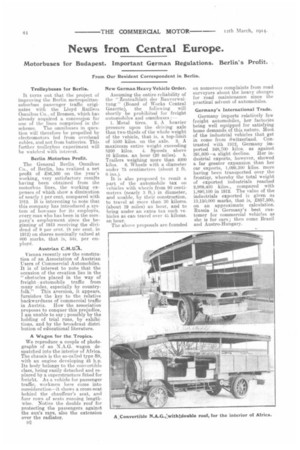News from Central Europe.
Page 20

If you've noticed an error in this article please click here to report it so we can fix it.
Motorbuses for Budapest. Important German Regulations. Berlin's Profit.
From Our Resident Correspondent in Berlin.
Trolleybuses for Berlin.
It turns out that the project of improving the Berlin metropolitansuburban passenger traffic originates with the Lloyd Railless Omnibus Co., of Bremen, which has already acquired a concession for one of the lines compriscrin the scheme. The omnibuses in question will therefore be propelled by electromotors fed from overhead cables, and not from batteries. This further trolleybus experiment will be watched with interest.
Berlin Motorbus Profit.
The General Berlin Omnibus Co., of Berlin, has realized a net profit of 186,500 on the year's working, very satisfactory results having been obtained from the motorbus lines, the working expenses of which show a diminution of nearly 1 per cent, compared with 1912. it is interesting to note that this company has introduced a system of bonuses for its employes, every man who has been in the company's employment since the beginning of 1913 receiving the dividend of 9 per cent. (8 per cent. in 1912) on shares nominally valued at 600 marks, that is, 54s, per employe. Austrian C.M.1.1.-A.
Vienna recently saw the constitution of an Association of Austrian Users of Commercial Automobiles. It is of interest to note that the occasion of the creation lies in the "obstacles placed in the way of freight automobile traffic from many sides, especially by countryfolk." This aversion, it appears, furnishes the key to the relative backwardness of commercial traffic in Austria. How the association proposes to conquer this prejudice, I am unable to say ; possibly by the holding of trial runs, by exhibitions, and by the broadcast distribution of educational literature.
A Wagon for the 'Tropics.
We reproduce a couple of photographs of an N.A.G. wagon despatched into the interior of Africa. The chassis is the so-called type 88, with an engine developing 45 h.p. Its body belongs to the convertible class, being easily detached and replaced by a superstructure fitted for freight. As a vehicle for passenger traffic, workmen here come into eonsideration---it shows a cross-seat behind the chauffeur's seat, and four rows of seats running lengthwise. Notice the double roof for protecting the passengers against the sun's rays, also the extension over the radiator.
P2 New German Heavy Vehicle Order.
Assuming the entire reliability of the " Zentralblatt der Bauverwaltung " (Board of Works Central Gazette), the following will shortly be prohibited for freight automobiles and omnibuses :— 1. Metal tires. 2. A heavier pressure upon the driving axle than two-thirds of the whole weight of the vehicle, that is, a top-limit of 5500 kilos. on the axle. 3. A maximum entire weight exceeding 8200 kilos. 4. Speeds above 16 kiloms. an hour (20 miles). 5. Trailers weighing more than 4000 kilos. 6. Wheels with a diameter under 75 centimetres (about 2 ft. 6 ins.).
It is also proposed to remit a part of the automobile tax on vehicles with wheels from 90 centimetres (nearly 3 ft.) in diameter, and unable, by their construction, to travel at more than 30 kiloms. (about 19 miles) an hour, and to bring under an extra tax such vehicles as can travel over 45 kiloms. an hour.
The above proposals are founded on numerous complaints from road surveyors about the heavy charges for road maintenance since the practical advent of automobiles.
Germany's International Trade.
Germany imports relatively few freight automobiles, her factories being well equipped for satisfying home demands of this nature_ Most of the industrial vehicles that get in come from Switzerland. Contrasted with 1912, Germany imported 348,700 kilos. as against 391,600—a slight decline. Her industrial exports, however, showed a far greater expansion than her car exports, 1,099,300 kilos. more having been transported over the frontier, whereby the total weight of exported industrials reached '2,989,400 kilos., compared with 1,890,100 in 1912. The value of the industrials exported is given as 13,150,000 marks, that is, 2657,500, on an approximate calculation. Russia is Germany's best customer for commercial vehicles as she is for ears.; then come Brazil and Austro-Hungary.


























